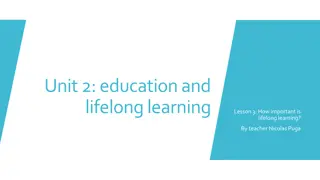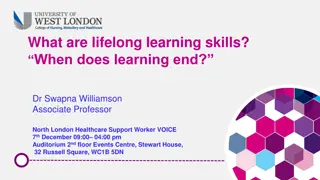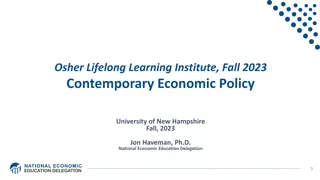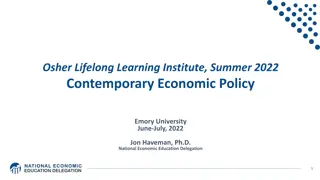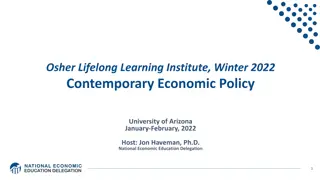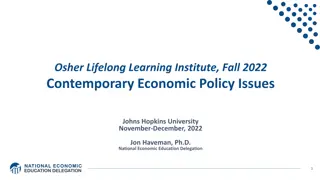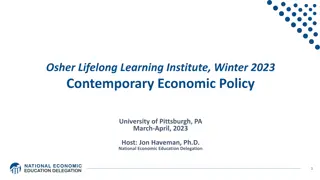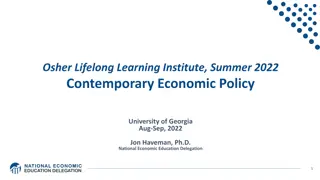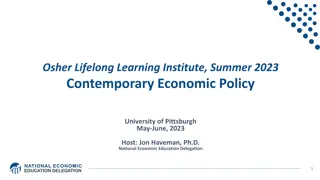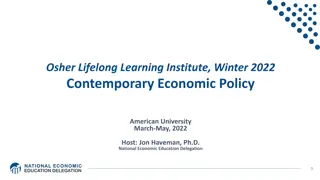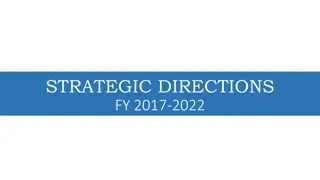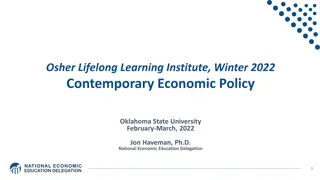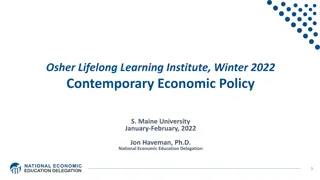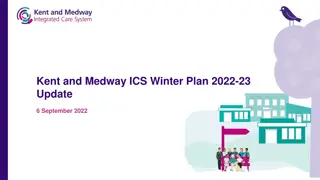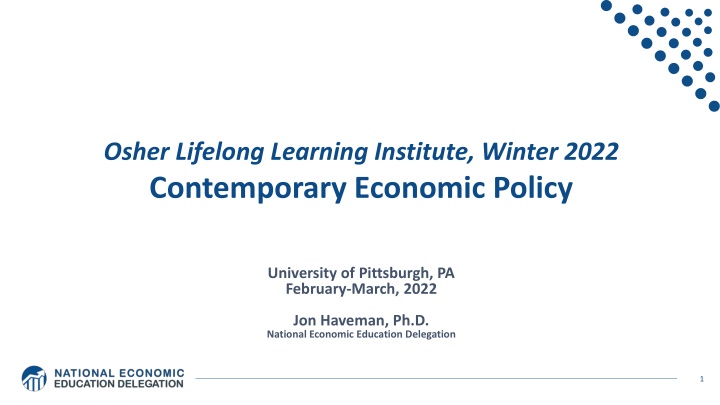
Osher Lifelong Learning Institute Winter 2022: Contemporary Economic Policy
Dive into the Winter 2022 session of the Osher Lifelong Learning Institute at the University of Pittsburgh, exploring Contemporary Economic Policy under the guidance of experts like Jon Haveman, Ph.D. Engage with the National Economic Education Delegation's mission and access a range of nonpartisan NEED topics. The course outline covers crucial aspects such as trade, globalization, US economy, coronavirus economics, the Black-White wealth gap, health economics, and economic inequality. Gain insights, submit questions for discussion, and explore the dynamics of the US economy amidst the challenges posed by the coronavirus pandemic.
Download Presentation

Please find below an Image/Link to download the presentation.
The content on the website is provided AS IS for your information and personal use only. It may not be sold, licensed, or shared on other websites without obtaining consent from the author. If you encounter any issues during the download, it is possible that the publisher has removed the file from their server.
You are allowed to download the files provided on this website for personal or commercial use, subject to the condition that they are used lawfully. All files are the property of their respective owners.
The content on the website is provided AS IS for your information and personal use only. It may not be sold, licensed, or shared on other websites without obtaining consent from the author.
E N D
Presentation Transcript
Osher Lifelong Learning Institute, Winter 2022 Contemporary Economic Policy University of Pittsburgh, PA February-March, 2022 Jon Haveman, Ph.D. National Economic Education Delegation 1
National Economic Education Delegation Vision - One day, the public discussion of policy issues will be grounded in an accurate perception of the underlying economic principles and data. Mission - NEED unites the skills and knowledge of a vast network of professional economists to promote understanding of the economics of policy issues in the United States. NEED Presentations - Are nonpartisan and intended to reflect the consensus of the economics profession. 2
Available NEED Topics Include: Coronavirus Economics Immigration Economics US Economy Housing Policy Climate Change Federal Budgets Economic Inequality Federal Debt Economic Mobility Black-White Wealth Gap Trade and Globalization Autonomous Vehicles Minimum Wages US Social Policy 3
Course Outline Contemporary Economic Policy - Week 1 (2/2): Trade and Globalization (Alan Deardorff, University of Michigan) - Week 2 (2/9): US Economy & Coronavirus Economics (Me) - Week 3 (2/16): The Black-White Wealth Gap (Stephanie Seguino, U-Vermont) - Week 4 (2/23): Health Economics (Veronika Dolar, SUNY, Old Westbury) - Week 5 (3/2): Economic Inequality (Me) 4
Submitting Questions Please submit questions in the chat. - I will try to handle them as they come up, but may take them in a bunch as time permits. We will do a verbal Q&A once the material has been presented. - And the questions in the chat have been addressed. OLLI allowing, we can stay beyond the end of class to have further discussion. 5
US Economy and Coronavirus Economics Jon Haveman, Ph.D. National Economic Education Delegation 6
Credits and Disclaimer This slide deck was authored by: - Jon D. Haveman, NEED - Scott Baier, Clemson University - Geoffrey Woglom, Amherst College (Emeritus) - Brian Dombeck, Lewis & Clark College - Doris Geide-Stevenson, Weber State Disclaimer - NEED presentations are designed to be nonpartisan. - It is, however, inevitable that the presenter will be asked for and will provide their own views. - Such views are those of the presenter and not necessarily those of the National Economic Education Delegation (NEED). 7
Outline State of the pandemic The U.S. Economy Hot Topics - Government policy - Debt - Inflation - Great resignation - Housing markets 8
Making Real ProgressUntil Omicron Nationally 10 Source: NYTimes
Omicron is Making Things Difficult Covid-related absences: - Are creating headaches for businesses that were struggling to hire workers even before Omicron. - Restaurants and retail stores have cut back hours. - Broadway shows called off performances. - Airlines canceled thousands of flights over the holidays because so many crew members called in sick; - on one day last month, nearly a third of United Airlines Workers at Newark Liberty International Airport, a major hub, called in sick. 11 Source: NYTimes.com
Pennsylvania Cases Are Falling Nicely Pennsylvania 12 Source: NYTimes
Some Basic Statistics Statistic: Value Population 331.9 Million Labor Force 163.7 Million Employment 149.6 Million Gross Domestic Product (GDP) $23.9 Trillion Income per Capita $63,002 Ave. Hourly Earnings $31.31 14
U.S. Economy in Global Perspective U.S. Real GDP (2019$): $21.845 trillion in 2019-Q4 $19.663 trillion in 2020-Q2 $22.531 trillion in 2021-Q4 15
Composition of the U.S. Economy: Employment Manufacturing GDP Share = 10.9% Health GDP Share = 7.4% 17
GDP Trajectory: Pandemic Plunge! Q3 - Flat GDP is: - $0.3 Trillion below 2019 forecast. - $0.7 Trillion ABOVE 2019-Q4 level. 20
Spending Patterns Since First US Case Q3 - Flat 21 Source: https://tracktherecovery.org/
Spending Patterns Hardest Hit Sectors +0.2% Transportation 23 Source: https://tracktherecovery.org/
Employment Gap 2.0 Million below February, 2020. 8.0 Million below where we should be. 26
Trends in Labor Force Participation 0.9 Million below February, 2020. 14.7 Million below where we should be. 28
Hot Topics Government policy Inflation Great resignation Housing markets 31
What Have Been Policy Effects? MONETARY POLICY (Fed) acted quickly and effectively to prevent a financial market meltdown and to keep credit flowing. But the Fed lends and does not spend. FISCAL POLICY (Congress) acted quickly, but inevitably made some mistakes. - Stimulus Checks, A ($268b) - Expanded Unemployment, B ($268b) - Paycheck Protection Program, C- ($525b) 32
Recovery Due to Immense Fiscal Stimulus and Control of COVID Sources of Personal Income (Billions of $s at Annual Rates, BEA) 23000.0 22000.0 21000.0 20000.0 19000.0 18000.0 17000.0 16000.0 15000.0 Before Tax Income After Tax Income 33
Stimulus allowed Spending to Recover Spending and Saving (Billions of $s at Annual Rates, BEA) 22000.0 But Note that Saving also went way up 20000.0 18000.0 Saving 16000.0 14000.0 Abnormally high Saving is over $2.8 trillion 12000.0 Personal Outlays After Tax Income 34
Abnormally High Savings Biden Boost Trump Bump CARES 35
Monetary Policy: Federal Reserve Primary goal is to keep interest rates low, to facilitate continued borrowing. - Federal Funds Rate rate at which banks lend to each other, usually overnight. - Purchases of U.S. Treasury securities keep money flowing to the government at low rates of interest. 36
Federal Reserve Assets 8.8 Largely Treasury Securities Pandemic Financial Crisis 3.8 1.0 39
Low Income Troubles 42
Current Deficits in Perspective: The budgetary cost of the 3 major fiscal packages during the pandemic was over $5 trillion. As a share of the economy this is almost the size of war production in 1943. (Romer, Brookings Papers on Economic Activity, 3/25/2021.) Since March of 2020, Fed net holdings of US Treasury bonds have increased by $5.0 trillion. 44
Inflation 45
46 Source: Investopedia
Were Buying Mostly Stuff Demand-Pull 47 Source: Jason Furman, PIIE
Inflation: Concentrated Cost-Push 48

